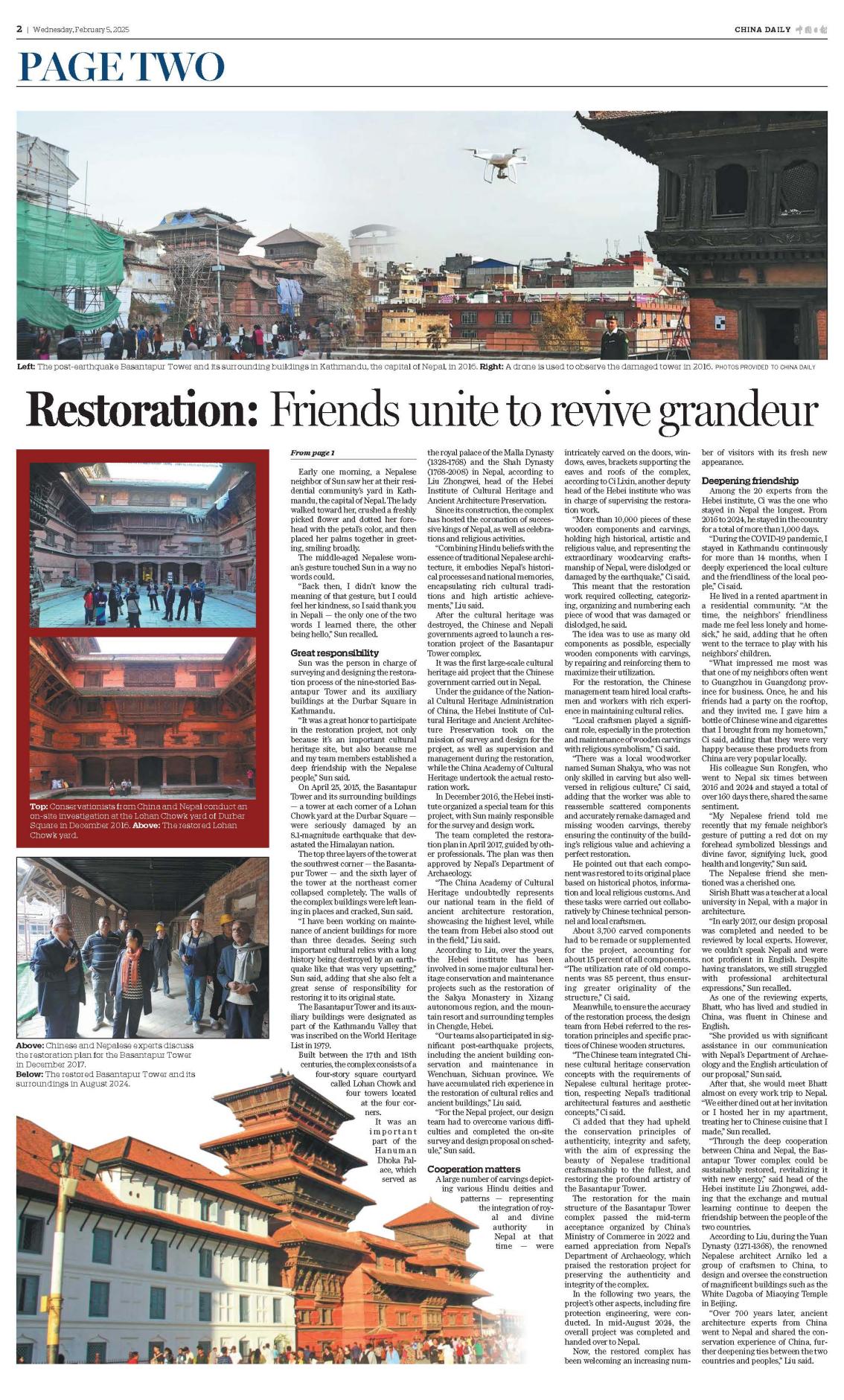中国日报网2月5日电(记者 张余) 2025年2月5日,《中国日报》头版及第2版整版刊发报道Chinese expertise helps restore damaged monument in Nepal。文章介绍了包括河北省文物与古建筑保护研究院在内的中国古建筑修复专家在长达八年的时间内,高质量完成尼泊尔九层神庙修复项目,为推动文明交流互鉴及促进两国人民相互了解作出了重要贡献。


以下为报道全文:
Chinese expertise helps restore damaged monument in Nepal
中国专家助力尼泊尔文化遗产修复
Nearly 10 years after it was severely damaged in a massive earthquake, Nepal’s iconic Basantapur Tower is once again welcoming visitors from all over the world as it stands tall in all its majesty, thanks to joint efforts by Chinese and Nepalese conservationists in restoring the World Heritage Site to its former glory.
在尼泊尔大地震近十年后,经过中尼两国文物保护工作者的共同努力,世界遗产地加德满都谷地的标志性建筑杜巴广场九层神庙(巴桑塔布尔塔)再次巍然耸立,恢复了往日的辉煌,迎接着来自世界各地的游客。
Sun Rongfen, 56, from North China’s Hebei province, was one of the key members of the team that worked on the restoration project. Over eight years, she and her colleagues spent a lot of time in Nepal, working diligently and in close cooperation with Nepalese counterparts to complete a challenging yet meaningful task, in the process strengthening bilateral people-to-people friendship.
For Sun, former deputy head of Hebei Institute of Cultural Heritage and Ancient Architecture Preservation, which was involved in restoring the site, one incident stands out vividly in her mind.
河北省文物与古建筑保护研究院原副院长孙荣芬是九层神庙修复项目团队的重要成员。在长达八年的时间里,她和同事们在尼泊尔坚守,不辞辛劳,与尼泊尔同行密切合作,圆满完成了这项充满挑战、意义重大的任务。在尼工作生活期间,有一件小事在她记忆中尤其深刻。
Early one morning, a Nepalese neighbor of Sun saw her at their residential community’s yard in Kathmandu, the capital of Nepal. The lady walked toward her, crushed a freshly picked flower and dotted her forehead with the petal’s color, and then placed her palms together in greeting, smiling broadly.
The middle-aged Nepalese woman’s gesture touched Sun in a way no words could.
“Back then, I didn’t know the meaning of that gesture, but I could feel her kindness, so I said thank you in Nepali — the only one of the two words I learned there, the other being hello,” Sun recalled.
在加德满都的一天清晨,孙荣芬来到项目驻地的公寓露台上,准备开始每日的晨练。正在晨祷的一位尼泊尔邻居看到了她,转身走来,笑容可掬,指间轻捻着一朵新采的鲜花,用花瓣的汁液点在她的额头上,然后双手合十柔声问候。
这位中年尼泊尔妇女的手势以一种无法言说的方式触动了孙荣芬。她回忆道:“我不知道那个手势的意思,但我能感受到她的善意,所以我用尼泊尔语说了‘谢谢’——当时我在那里才刚学到两个词,另一个是‘你好’。”
Great responsibility
肩负重任
Sun was the person in charge of surveying and designing the restoration process of the nine-storied Basantapur Tower and its auxiliary buildings at the Durbar Square in Kathmandu.
“It was a great honor to participate in the restoration project, not only because it’s an important cultural heritage site, but also because me and my team members established a deep friendship with the Nepalese people,” Sun said.
孙荣芬负责加德满都杜巴广场九层神庙修复项目的勘测设计工作。
她说:“我很荣幸能参与这个修复项目,不仅因为它是一个重要的文化遗产,还因为我和我的团队成员与尼泊尔人民建立了深厚的友谊。”
On April 25, 2015, the Basantapur Tower and its surrounding buildings — a tower at each corner of a Lohan Chowk yard at the Durbar Square — were seriously damaged by an 8.1-magnitude earthquake that devastated the Himalayan nation.
The top three layers of the tower at the southwest corner — the Basantapur Tower — and the sixth layer of the tower at the northeast corner collapsed completely. The walls of the complex buildings were left leaning in places and cracked, Sun said.
“I have been working on maintenance of ancient buildings for more than three decades. Seeing such important cultural relics with a long history being destroyed by an earthquake like that was very upsetting,” Sun said, adding that she also felt a great sense of responsibility for restoring it to its original state.
2015年4月25日,灾难降临在这个喜马拉雅山麓的国度,加德满都杜巴广场九层神庙及其附属建筑在8.1级地震中受损严重。
西南角塔上部三层和东北角塔第六层完全塌毁。大部分建筑墙体发生倾斜、开裂,披檐坍塌、扭曲变形,神庙整体面目皆非。谈到抵达现场时的第一印象,孙荣芬说:“我三十多年来都在从事古建筑的保护工作,亲见历史如此悠久、价值如此重要的文物建筑损毁,心痛不已。”她强调说,将九层神庙恢复原状,责任重大。
The Basantapur Tower and its auxiliary buildings were designated as part of the Kathmandu Valley that was inscribed on the World Heritage List in 1979.
Built between the 17th and 18th centuries, the complex consists of a four-story square courtyard called Lohan Chowk and four towers located at the four corners.
It was an important part of the Hanuman Dhoka Palace, which served as the royal palace of the Malla Dynasty (1328-1768) and the Shah Dynasty (1768-2008) in Nepal, according to Liu Zhongwei, head of the Hebei Institute of Cultural Heritage and Ancient Architecture Preservation.
Since its construction, the complex has hosted the coronation of successive kings of Nepal, as well as celebrations and religious activities.
“Combining Hindu beliefs with the essence of traditional Nepalese architecture, it embodies Nepal's historical processes and national memories, encapsulating rich cultural traditions and high artistic achievements,” Liu said.
加德满都谷地于1979年被列入世界遗产名录,九层神庙及其附属建筑是其重要组成部分。该建筑群建于17世纪至18世纪,由名为罗罕庭院的四层回字形建筑和耸立四隅的塔楼组成。
据河北省文物与古建筑保护研究院院长刘忠伟介绍,这是哈努曼多卡宫的重要组成部分,哈努曼多卡宫曾是尼泊尔马拉王朝(1328-1768)和沙阿王朝(1768-2008)的王宫。
自建成以来,该建筑群举办了尼泊尔历届国王的加冕仪式以及许多重大的庆典和宗教活动。
刘忠伟说:“它把印度教信仰与纽瓦丽式建筑融合在一起,承载着尼泊尔的历史进程和民族记忆,积淀着丰厚的文化底蕴和高度的艺术成就。”
After the cultural heritage was destroyed, the Chinese and Nepali governments agreed to launch a restoration project of the Basantapur Tower complex.
It was the first large-scale cultural heritage aid project that the Chinese government carried out in Nepal.
Under the guidance of the National Cultural Heritage Administration of China, the Hebei Institute of Cultural Heritage and Ancient Architecture Preservation took on the mission of survey and design for the project, as well as supervision and management during the restoration, while the China Academy of Cultural Heritage undertook the actual restoration work.
In December 2016, the Hebei institute organized a special team for this project, with Sun mainly responsible for the survey and design work.
The team completed the restoration plan in April 2017, guided by other professionals. The plan was then approved by Nepal's Department of Archaeology.
“The China Academy of Cultural Heritage undoubtedly represents our national team in the field of ancient architecture restoration, showcasing the highest level, while the team from Hebei also stood out in the field,” Liu said.
在九层神庙遭受地震破坏后,中尼两国协商决定,中国政府承担援尼泊尔加德满都杜巴广场九层神庙震后修复项目。
这是中国政府在尼泊尔开展的首个大规模文物援外项目。
在国家文物局的指导下,河北省文物与古建筑保护研究院承担了该项目的勘察设计,以及修复过程中的项目管理任务,中国文化遗产研究院承担了项目施工任务。
2016年12月,河北省文物与古建筑保护研究院为此组成专项团队奔赴尼泊尔,孙荣芬主要负责勘察设计工作。
2017年4月,编制完成了修复设计方案,该方案随后获得了尼泊尔考古局的批准。
刘忠伟说:“中国文化遗产研究院无疑代表了我们在古建筑修复领域的国家队,展示了最高水平,而河北队也在该领域脱颖而出。”
According to Liu, over the years, the Hebei institute has been involved in some major cultural heritage conservation and maintenance projects such as the restoration of the Sakya Monastery in Xizang autonomous region, and the mountain resort and surrounding temples in Chengde, Hebei.
“Our teams also participated in significant post-earthquake projects, including the ancient building conservation and maintenance in Wenchuan, Sichuan province. We have accumulated rich experience in the restoration of cultural relics and ancient buildings,” Liu said.
“For the Nepal project, our design team had to overcome various difficulties and completed the on-site survey and design proposal on schedule,” Sun said.
刘忠伟介绍,多年以来,河北省文物与古建筑保护研究院承担了一些重大的文化遗产保护项目,如西藏自治区萨迦寺、河北承德的避暑山庄和周边寺庙的保护修缮等。
刘忠伟说:“我们的团队还承担了多个震后项目,包括四川汶川地震后的古建筑保护维缮。通过这些项目,我们在文物古建筑修复方面积累了丰富的经验。”
孙荣芬说:“在尼泊尔项目中,我们的设计团队克服了各种困难,按时完成了现场勘察,提交了设计方案。”
Cooperation matters
中尼合作现成果
A large number of carvings depicting various Hindu deities and patterns — representing the integration of royal and divine authority in Nepal at that time — were intricately carved on the doors, windows, eaves, brackets supporting the eaves and roofs of the complex, according to Ci Lixin, another deputy head of the Hebei institute who was in charge of supervising the restoration work.
“More than 10,000 pieces of these wooden components and carvings, holding high historical, artistic and religious value, and representing the extraordinary woodcarving craftsmanship of Nepal, were dislodged or damaged by the earthquake,” Ci said.
负责项目管理工作的河北省文物与古建筑保护研究院副院长次立新表示,建筑群的门窗与檐柱上、披檐和斜撑上,雕刻有大量印度教的神祇和图案,代表了尼泊尔当时王权和神权的高度融合。
次立新说:“10000多件木构件和木雕刻因地震被损坏或散落,这些木构件和木雕刻具有较高历史、艺术和宗教价值,代表了尼泊尔非凡的木雕工艺。”
This meant that the restoration work required collecting, categorizing, organizing and numbering each piece of wood that was damaged or dislodged, he said.
The idea was to use as many old components as possible, especially wooden components with carvings, by repairing and reinforcing them to maximize their utilization.
For the restoration, the Chinese management team hired local craftsmen and workers with rich experience in maintaining cultural relics.
“Local craftsmen played a significant role, especially in the protection and maintenance of wooden carvings with religious symbolism,” Ci said.
他说,这意味着修复工作需要将震后损坏和散落的每一块木料进行收集、分类、整理和编号,根据历史照片和资料及当地的宗教习俗,让它们恢复原位。尽量使用旧构件是本次修复的重要原则,尤其对于带有雕刻的木构件,通过修补加固使其得以最大限度的利用。
为了进行修复,中国管理团队聘请了当地在文物保护方面经验丰富的工匠。
“尤其在对具有宗教寓意的木雕刻保护维修中,当地工匠发挥了很大作用。”
“There was a local woodworker named Suman Shakya, who was not only skilled in carving but also well-versed in religious culture,” Ci said, adding that the worker was able to reassemble scattered components and accurately remake damaged and missing wooden carvings, thereby ensuring the continuity of the building's religious value and achieving a perfect restoration.
He pointed out that each component was restored to its original place based on historical photos, information and local religious customs. And these tasks were carried out collaboratively by Chinese technical personnel and local craftsmen.
About 3,700 carved components had to be remade or supplemented for the project, accounting for about 15 percent of all components. “The utilization rate of old components was 85 percent, thus ensuring greater originality of the structure,” Ci said.
“有一位叫Suman Shakya的当地木工工匠,不但雕刻技艺精湛,而且精通宗教文化,既能将散落构件进行归位,又能对残损和缺失木雕刻进行较为准确的补配,使建筑的宗教价值得以延续,取得较好修复效果,”次立新说。
他指出,这些工作是由中方技术人员和当地工匠共同完成的。
据统计,项目合计重做补配雕刻构件3700余件,约占全部构件的15%,老旧构件利用率达85%,最大限度保护了其原有信息。
Meanwhile, to ensure the accuracy of the restoration process, the design team from Hebei referred to the restoration principles and specific practices of Chinese wooden structures.
“The Chinese team integrated Chinese cultural heritage conservation concepts with the requirements of Nepalese cultural heritage protection, respecting Nepal’s traditional architectural features and aesthetic concepts,” Ci said.
Ci added that they had upheld the conservation principles of authenticity, integrity and safety, with the aim of expressing the beauty of Nepalese traditional craftsmanship to the fullest, and restoring the profound artistry of the Basantapur Tower.
同时,为了确保修复过程的准确性,河北的设计团队参考了中国木结构建筑修复的原则和具体实践。
次立新说:“在九层神庙修复过程中,中国团队把中国文物保护理念与尼泊尔文化遗产保护要求相结合,尊重尼泊尔传统的建筑特色和审美理念,秉持真实性、整体性和安全性的保护理念,把尼泊尔的传统工艺之美淋漓尽致地表达出来,重塑九层神庙极富震撼力的艺术世界。”
The restoration for the main structure of the Basantapur Tower complex passed the mid-term acceptance organized by China’s Ministry of Commerce in 2022 and earned appreciation from Nepal’s Department of Archaeology, which praised the restoration project for preserving the authenticity and integrity of the complex.
In the following two years, the project’s other aspects, including fire protection engineering, were conducted. In mid-August 2024, the overall project was completed and handed over to Nepal.
Now, the restored complex has been welcoming an increasing number of visitors with its fresh new appearance.
2022年12月,九层神庙建筑群本体修复通过了中国商务部国际经济合作事务局组织的中期验收。时任尼泊尔考古局局长高塔姆称赞该修复项目保护了建筑群的真实性与完整性。
在接下来的两年里,该项目的其他方面,包括消防工程,都得到了实施。2024年8月中旬,整个项目竣工并移交给尼泊尔。
现在,这座经过修复的建筑群以其崭新的面貌迎接着越来越多的游客。
Deepening friendship
友谊加深
Among the 20 experts from the Hebei institute, Ci was the one who stayed in Nepal the longest. From 2016 to 2024, he stayed in the country for a total of more than 1,000 days.
“During the COVID-19 pandemic, I stayed in Kathmandu continuously for more than 14 months, when I deeply experienced the local culture and the friendliness of the local people,” Ci said.
He lived in a rented apartment in a residential community. “At the time, the neighbors’ friendliness made me feel less lonely and homesick,” he said, adding that he often went to the terrace to play with his neighbors’ children.
“What impressed me most was that one of my neighbors often went to Guangzhou in Guangdong province for business. Once, he and his friends had a party on the rooftop, and they invited me. I gave him a bottle of Chinese wine and cigarettes that I brought from my hometown,” Ci said, adding that they were very happy because these products from China are very popular locally.
His colleague Sun Rongfen, who went to Nepal six times between 2016 and 2024 and stayed a total of over 160 days there, shared the same sentiment.
在河北省文物与古建筑保护研究院的20位专家中,次立新是在尼泊尔驻留时间最长的一位。从2016年到2024年,他累计坚守了1000多天。
“新冠疫情期间,我在加德满都连续驻留了14个月,深刻体会了当地文化,也充分感受到当地人民的友好,”次立新说。
他当时住在一个租来的公寓里。
“当时,友善的邻居们让我不那么孤独和想家,”他说,他经常去露台和邻居的孩子们一起运动。
“给我印象最深的是,有一次,我的一个邻居在屋顶上举办了聚会,他和他的朋友邀请了我。我送给他们一瓶我从家乡带来的中国白酒和香烟,”次立新说,他们非常高兴,因为这些来自中国的产品在当地很受欢迎。
孙荣芬也有同样的感受。她在2016年至2024年间也曾六次前往尼泊尔,在那里待了160多天。
“My Nepalese friend told me recently that my female neighbor’s gesture of putting a red dot on my forehead symbolized blessings and divine favor, signifying luck, good health and longevity,” Sun said.
The Nepalese friend she mentioned was a cherished one.
Sirish Bhatt was a teacher at a local university in Nepal, with a major in architecture.
“In early 2017, our design proposal was completed and needed to be reviewed by local experts. However, we couldn’t speak Nepali and were not proficient in English. Despite having translators, we still struggled with professional architectural expressions,” Sun recalled.
As one of the reviewing experts, Bhatt, who has lived and studied in China, was fluent in Chinese and English.
“She provided us with significant assistance in our communication with Nepal's Department of Archaeology and the English articulation of our proposal,” Sun said.
After that, she would meet Bhatt almost on every work trip to Nepal. “We either dined out at her invitation or I hosted her in my apartment, treating her to Chinese cuisine that I made,” Sun recalled.
孙荣芬说:“我的尼泊尔朋友告诉我,邻居在我额头上点红,象征着神佑和赐福,寓意着幸运和健康长寿。”
她提到的尼泊尔朋友是一位难得的挚友——Sirish Bhatt。
Sirish Bhatt是尼泊尔当地一所大学的教师,主修建筑学。
孙荣芬回忆道:“2017年初,我们的设计方案已经完成,需要经过当地专家的审查。虽然有翻译,但我们仍然在专业建筑术语方面遇到了困难。”
作为评审专家之一,Sirish Bhatt曾在中国生活和学习,精通中文和英文。
孙荣芬说:“她帮助我们与尼泊尔考古局进行沟通,并对规范设计方案中的英文表达提供了重要帮助。”
在那之后,她几乎每次去尼泊尔出差都会和Sirish Bhatt会面。“有时她请我们出去吃尼餐,有时我们请她到公寓吃我们做的中餐。”
“Through the deep cooperation between China and Nepal, the Basantapur Tower complex could be sustainably restored, revitalizing it with new energy,” said head of the Hebei institute Liu Zhongwei, adding that the exchange and mutual learning continue to deepen the friendship between the people of the two countries.
According to Liu, during the Yuan Dynasty (1271-1368), the renowned Nepalese architect Arniko led a group of craftsmen to China, to design and oversee the construction of magnificent buildings such as the White Dagoba of Miaoying Temple in Beijing.
“Over 700 years later, ancient architecture experts from China went to Nepal and shared the conservation experience of China, further deepening ties between the two countries and peoples,” Liu said.
河北省文物与古建筑保护研究院院长刘忠伟表示:“通过中尼之间的深度合作,九层神庙建筑群得以恢复原有面貌,焕发更绚烂的光彩。”交流互鉴将继续加深两国人民之间的友谊。
在元代时,尼泊尔著名工艺家阿尼哥率工匠来华,主持修建了北京妙应寺白塔等宏伟建筑。
刘忠伟说:“700多年后,中国古建筑专家前往尼泊尔,分享中国的文化遗产保护经验,进一步加深了两国和两国人民之间的联系。”